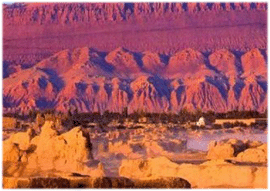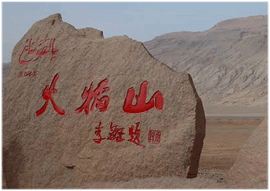As one of the hottest places on earth, Flaming Mountain has always been a famous tourist attraction, with its harsh yet unique natural conditions, as well as abundant cultural heritage.
Located on the northern edge of the Turpan Basin, Flaming Mountain runs 10 kilometers east of  Turpan city, stretching up to 100 kilometers from east to west and about 10 kilometers from south to north. The mountain begins at Liusha River in Shanshan County in the east and ends in Peach Valley in the west. Turpan city, stretching up to 100 kilometers from east to west and about 10 kilometers from south to north. The mountain begins at Liusha River in Shanshan County in the east and ends in Peach Valley in the west.
The mountain's average altitude is about 500 meters, with the highest peak, Shengjinkou, towering 831 meters above sea level. Known as Red Rock Mountain in ancient Chinese classics, or Keziletage ("Red Mountain") in Uygur, Flaming Mountain is largely made up of bare rock.
Not a single blade of grass grows on the hills of Flaming Mountain and there are no traces of birds or animals there. When the July sun heats the bare rocks, the blazing air current rolls up like burning flames.
In the summer, the region gets so hot that you can "hard boil" an egg by burying it in the sand for just a few minutes. With strong direct radiation from the sun, the highest temperatures can reach 47.8  degrees Celsius and the earth's surface temperature can top 70 degrees. From a distance, at the foot of the mountain, dozens of the red rock hills look like flaming fireballs under the blazing sun - hence its name, Flaming Mountain. degrees Celsius and the earth's surface temperature can top 70 degrees. From a distance, at the foot of the mountain, dozens of the red rock hills look like flaming fireballs under the blazing sun - hence its name, Flaming Mountain.
However, its natural allure is not characterized by mere heat. Behind the sterile rock mountains, there are many hidden valleys shaped by diastrophism millions of years ago. The natural conditions of these valleys, which abound with various plants and trees, are quite different. The most famous ones include Grape Valley, Peach Valley, Wood Valley and Shengjinkou Valley. Among them, Grape Valley is best known for producing the best grapes in the country. These "green islands" add extra glamour and diversity to the deserted Flaming Mountain. |
